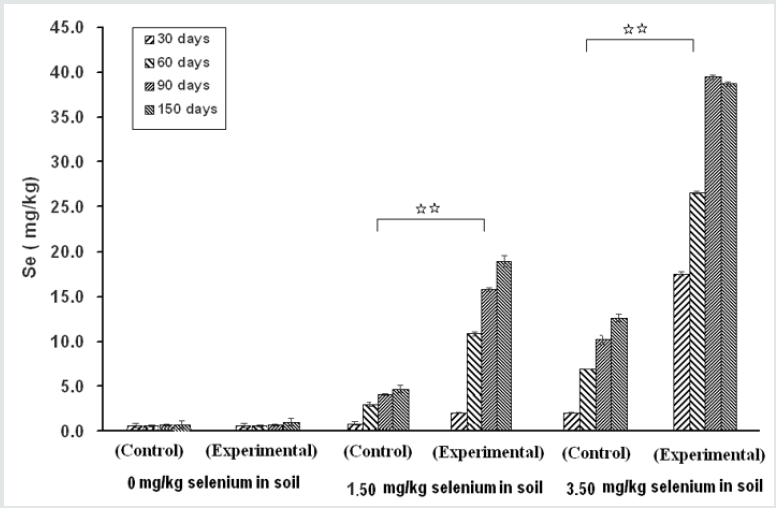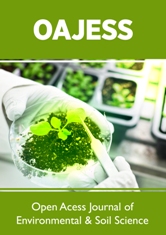
Lupine Publishers Group
Lupine Publishers
Menu
ISSN: 2641-6794
Review article2641-6794 
Effective Transformation and Utilization of Selenate/ Selenite in Soil by Tea Plants Infected with Endophytic Herbaspirillum sp. Strain WT00F Volume 4 - Issue 4
Xingguo Wang1* and Yong Zhang2
- 1State Key Laboratory of Biocatalysis and Enzyme Engineering, Hubei University, China
- 2Xianning Central Hospital, Tongji Xianning Hospital, China
Received: January 20, 2020; Published: January 28, 2020
Corresponding author: Xingguo Wang, State Key Laboratory of Biocatalysis and Enzyme Engineering, Hubei University, China
DOI: 10.32474/OAJESS.2020.04.000191
Abstract
A novel technique was used to transform and utilize selenate/selenite in soil. Tea seedlings ontainingHerbaspirillum sp.strain WT00F were cultivated and then transplanted in leniferous soils. The grown tea plants not only effectively reduced the level of selenate/selenite in ferous soils but also enhanced selenium enrichment in tea leaves.
Introduction: As a nonmetallic element, selenium (Se) is a member of the chalcogens. In the nature, Se usually occurs in organic and inorganic forms. Its organic form (e.g. selenocysteine and selenoproteins, etc) mainly presents in living organisms where the organic selenocompounds can be metabolized [1,2], whereas its inorganic form (e.g. selenate and selenite oxoanions) primarily exists in natural environments. Selenate (SeO42-) and selenite (SeO32-) are water soluble so that they have potential mobility and bioavailability in the environment [3]. At low dosage, Se stimulates the growth of the plant whereas at high dosages it causes plant damage [4-6]. The deficiency of Se has been thought to be associated with over 40 human diseases [7,8] but the excessive intake of Se seriously damages human health [9]. Although the distribution area of Se is limited, Se-pollution in the surrounding land of selenium mining area is quite serious. Soluble Se6+ and Se4+ can be reduced to insoluble non-toxic elemental selenium (Seo) by microbes. The reduction of selenate/selenite to elemental selenium by microbes is an effective way to remove them from contaminated soil, water and drainage [10]. Herbaspirillum sp. strain WT00F is an endophytic bacterium isolated from tea plant (Camellia sinensis L) [11]. It enters plants via wound infection and only colonizes in Camellia plants as a specialist. Like Herbaspirillum sp. strain WT00C [12], this bacterium has a strong capability of reducing selenate and selenite to form red elemental selenium (Seo) or selenoproteins. Moreover, this bacterium also stimulates lateral root formation and bud growth of tea cuttings once it enters tea pole via the incision at the end of tea cuttings [13]. Thus, we attempted to use this bacterium to promote tea plants to transform and utilize selenate/selenite in soil and found that the tea plants colonized by Herbaspirillum sp. strain WT00F effectively utilized selenate/selenite in soil and enriched selenium in tea leaves.
Technological Scheme
The technical route was simply described as follows: Herbaspirillum sp. strain WT00F was cultured in the modified LB medium (yeast extract 5g, peptone 10g, NaCl 1.5g in 1L H2O, pH7.0) at 37°C until OD600 of 1.0. Tea cuttings (5-7 cm length) were soaked in the bacterial culture supplemented 1% glycerol and diluted with H2O (1:1) for 1h. Then, tea cuttings infected by Herbaspirillum sp.strain WT00F were planted in the nursery to grow into tea seedlings. Finally, tea seedlings were transplanted in seleniferous soils. The field management was performed according to the conventional method for tea cultivation
Experimental Effects and Discussion
Transformation and utilization of selenate/selenite in soil were very effective via planting tea plants colonized by the strain WT00F. Figure.1 showed selenium enrichment in tea leaves. In the tea plants colonized by the strain WT00F, selenium amount of tea leaves was increased 2-3 fold compared to the tea plant without colonization of the strain WT00F. Effective transformation of selenate by the bacterium inside tea plant accelerated selenate absorption of tea-plant roots and thus reduced the level of selenate in soil. The possible mechanism of transforming and utilizing selenate/selenite in soil by tea plants infected with the strain WT00F is proposed as follows: when tea plants grow in seleniferous soils, selenate/ selenite enters tea plants via root absorption and reaches to teaplant stem through vessel transportation. As we known, selenate/ selenite are soluble but quite toxic [14], whereas elemental selenium (Se0) is insoluble and atoxic [15,16]. Herbaspirillum sp. WT00F predominantly colonizes inside the stem of tea plants, and effectively reduces selenate/selenite to produce elemental selenium, selenodiglutathione, glutathioselenol, selenocysteine, selenomethionine and selenoproteins when inorganic selenocompounds are absorbed via roots and transported into the stems of tea plants through the conducting system of tea-plant xylem. Thus, the strain WT00F not only decreases the toxicity of inorganic selenocompounds absorbed by roots but also forms organic selenium and Se-nanoparticles. Organic selenium and Se-nanoparticles can be further metabolized by tea-plant cells and finally accumulated in the tissues of tea leaves. In conclusion, applying this technique not only effectively reduces the level of selenate/selenite in seleniferous soils but also enhances Seenrichment in tea leaves.
Figure 1: Selenium contents of tea leaves. The data were collected at 30, 60, 90 and 150 days after the survival and growth of tea seedlings transplanted in the soils containing 0, 1.5 and 3.5 mg/kg selenate. Control: tea seedlings without bacterial treatment; Experimental: tea seedlings infected with the strain WT00F; ☆☆: P<0.01.

Acknowledgement
This work was supported by the grant (2015CFA089) from Science and Technology Department of Hubei Province, China.
References
- Ip C, Thompson HJ, Zhu Z, Ganther HE (2000) In vitro and in vivo studies of methylseleninic acid: evidence that a monomethylated selenium metabolite is critical for cancer chemoprevention. Cancer Res 60(1):2882-2886.
- Miller S, Walker SW, Arthur JR, Nicol F, Pickard K, et al.(2001) Selenite protects human endothelial cells from oxidative damage and induces thioredoxin reductase. Clin Sci100(5):543-550.
- Strawn D, Doner H, Zavarin M, McHugo S (2002) Microscale investigation into the geochemistry of arsenic, selenium, and iron in soil developed in pyritic shale materials. Geoderma108:237-257.
- Turakainen M, Hartikainen H, Seppanen MM (2004)Effects of selenium treatments on potato (Solanum tuberosum L.) growth and concentrations of soluble sugars and starch. J Agric Food Chem 52(17):5378-5382.
- Hartikainen H, Xue T, Piironen V (2000) Selenium as an antioxidant and pro-oxidant in ryegrass. Plant Soil 225:193-200.
- Lyons GH, Genc Y, Soole K, Stangoulis JCR, Liu F, et al. (2009)Selenium increases seed production in Brassica. Plant Soil 318:73-80.
- Tapiero H, Townsend DM, Tew KD (2003 ) The antioxidant role of selenium and seleno-compounds. BiomPharmaco 57(3-4):134-144.
- Cox DN, Bastiaans K (2007) Understanding Australian consumers perceptions of selenium and motivations to consume selenium enriched foods. Food Qua Pref18(1):66-76.
- Ruta DA, Haider S (1989 ) Attempted murder by selenium poisoning. BMJ 299(6694):316-317.
- Dungan RS, Frankenberger T (1999)Microbial transformations of selenium and the bioremediation of seleniferous environments. Biorem J3(3):171-188.
- Wang T, Yang S, Chen Y, Hu L, Tu Q, et al. (2014) Microbiological properties of two endophytic bacteria isolated from tea (Camellia sinensis L.). Acta Microbiol Sin 54(4):424-432.
- Xu X, Cheng W, Liu X, You H, Wu G, et al. (2019) Selenate Reduction and Selenium Enrichment of Tea by the endophytic Herbaspirillum sp. Strain WT00C. Curr Microbiol 11(3):1-14.
- Zhan G, Cheng W, Liu W, Li Y, Ding K, et al. (2016) Infection, colonization and growth-promoting effects of tea plant (Camelliasinensis L.) by the endophytic bacterium Herbaspirillumsp. WT00C. AfrJAgric Res 11(3): 130-138.
- Lyons GH, Genc Y, Soole K, Stangoulis JCR, Liu F, et al.(2009) Selenium increases seed production in Brassica. Plant Soil 318:73-80.
- Hartikainen H, Xue T, Piironen V (2000) Selenium as an antioxidant and pro-oxidant in ryegrass. Plant Soil225(1-2):193-200
- Wadhwani SA, Shedbalkar UU, Singh R ,Chopade BA (2016)Biogenic selenium nanoparticles: current status and future prospects. Appl Microbiol Biotechnol 100(6):2555-2566.

Top Editors
-

Mark E Smith
Bio chemistry
University of Texas Medical Branch, USA -

Lawrence A Presley
Department of Criminal Justice
Liberty University, USA -

Thomas W Miller
Department of Psychiatry
University of Kentucky, USA -

Gjumrakch Aliev
Department of Medicine
Gally International Biomedical Research & Consulting LLC, USA -

Christopher Bryant
Department of Urbanisation and Agricultural
Montreal university, USA -

Robert William Frare
Oral & Maxillofacial Pathology
New York University, USA -

Rudolph Modesto Navari
Gastroenterology and Hepatology
University of Alabama, UK -

Andrew Hague
Department of Medicine
Universities of Bradford, UK -

George Gregory Buttigieg
Maltese College of Obstetrics and Gynaecology, Europe -

Chen-Hsiung Yeh
Oncology
Circulogene Theranostics, England -
.png)
Emilio Bucio-Carrillo
Radiation Chemistry
National University of Mexico, USA -
.jpg)
Casey J Grenier
Analytical Chemistry
Wentworth Institute of Technology, USA -
Hany Atalah
Minimally Invasive Surgery
Mercer University school of Medicine, USA -

Abu-Hussein Muhamad
Pediatric Dentistry
University of Athens , Greece

The annual scholar awards from Lupine Publishers honor a selected number Read More...




